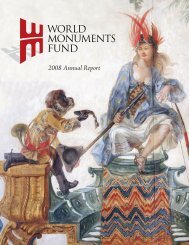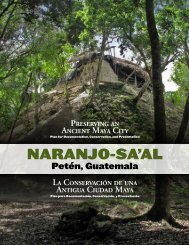Summary of the Proceedings and Papers Presented at - World ...
Summary of the Proceedings and Papers Presented at - World ...
Summary of the Proceedings and Papers Presented at - World ...
Create successful ePaper yourself
Turn your PDF publications into a flip-book with our unique Google optimized e-Paper software.
The Casa delle Nozze díArgento:<br />
A Preliminary, Definitive <strong>and</strong><br />
Executive Project for Restor<strong>at</strong>ion<br />
by Paolo Marconi<br />
The protection <strong>of</strong> archaeological remains faces an asyet<br />
unsolved dilemma. On <strong>the</strong> one h<strong>and</strong>, <strong>the</strong>re are<br />
<strong>the</strong> rosy prospects <strong>of</strong>fered by <strong>the</strong> ranks <strong>of</strong> ‘conserv<strong>at</strong>ionists’,<br />
still powerful in academic circles, who may<br />
not underst<strong>and</strong> th<strong>at</strong> archaeological remains are not subject<br />
to <strong>the</strong> universal laws <strong>of</strong> entropy. They develop fancy ideas—<br />
aided by all kinds <strong>of</strong> specialists—for wh<strong>at</strong> <strong>the</strong>y call ‘pure’ conserv<strong>at</strong>ion<br />
projects, which viewed with hindsight last only a<br />
few years. Wh<strong>at</strong>ever <strong>the</strong> dur<strong>at</strong>ion <strong>of</strong> <strong>the</strong>se works or <strong>the</strong>ir<br />
effect on <strong>the</strong> structures, <strong>the</strong>y <strong>of</strong>ten result in <strong>the</strong> archaeological<br />
remains being more “ruined” than before, all in a kind <strong>of</strong><br />
indulgence among <strong>the</strong>ir educ<strong>at</strong>ors <strong>and</strong> superintendents <strong>and</strong><br />
<strong>the</strong> public <strong>at</strong> large, who is interested in ruins as objects, but<br />
not in <strong>the</strong>ir historical or scientific values. We should remember<br />
th<strong>at</strong> most visitors, wherever <strong>the</strong>y come from, are more<br />
interested in plaster casts <strong>of</strong> dead Pompeians, than <strong>the</strong>y are<br />
in underst<strong>and</strong>ing Pompeian houses.<br />
On <strong>the</strong> o<strong>the</strong>r h<strong>and</strong> <strong>the</strong> Superintendents would need to<br />
take an uncomfortable position when <strong>the</strong> project is not ‘conserv<strong>at</strong>ionist’,<br />
such as <strong>the</strong> one illustr<strong>at</strong>ed here, while trying to<br />
solve <strong>the</strong> difficult problem <strong>of</strong> <strong>the</strong> decay <strong>of</strong> m<strong>at</strong>erials, structures,<br />
<strong>and</strong> infrastructures.<br />
This question has evolved because <strong>the</strong>re has been a<br />
movement in Italy since <strong>the</strong> 1960s (as a result <strong>of</strong> <strong>the</strong> growing<br />
importance <strong>of</strong> cultural tourism <strong>and</strong> <strong>the</strong> problems mentioned<br />
above) th<strong>at</strong> has led to <strong>the</strong> idea th<strong>at</strong> archaeological restor<strong>at</strong>ion<br />
is mainly concerned with consolid<strong>at</strong>ing <strong>the</strong> remains <strong>of</strong><br />
collapsed buildings. The result has been th<strong>at</strong> <strong>the</strong>se very same<br />
“conserved” remains have since fallen into ruin <strong>at</strong> many sites.<br />
Most <strong>of</strong> <strong>the</strong>m have become weed-ridden heaps <strong>of</strong> stones<br />
ra<strong>the</strong>r than <strong>the</strong> remains <strong>of</strong> buildings, <strong>and</strong> are exposed to <strong>the</strong><br />
elements, as well as to pollution, earthquakes, <strong>and</strong> regular<br />
wear <strong>and</strong> tear by visitors, leading to an even worse situ<strong>at</strong>ion.<br />
Wh<strong>at</strong> has prevailed <strong>the</strong>n is a concept <strong>of</strong> <strong>the</strong> ruin as a romantic<br />
<strong>and</strong> picturesque l<strong>and</strong>scape without any consider<strong>at</strong>ions<br />
for its architectonic value.<br />
In ano<strong>the</strong>r country, Greece, which tops <strong>the</strong> list <strong>of</strong> peoples’<br />
interest for classical antiquities, <strong>the</strong> approach <strong>of</strong> conserv<strong>at</strong>ionists,<br />
under <strong>the</strong> w<strong>at</strong>chful eye <strong>of</strong> <strong>the</strong> European Union<br />
<strong>and</strong> <strong>the</strong> archaeological community, is very different. In<br />
Greece, we find a system<strong>at</strong>ic process based on reconstructing<br />
ancient ruins—including <strong>the</strong> Acropolis in A<strong>the</strong>ns <strong>and</strong> <strong>the</strong><br />
temple <strong>at</strong> Bassae—by reassembling <strong>the</strong>ir remains sc<strong>at</strong>tered<br />
about <strong>the</strong> area. The stones are collected, c<strong>at</strong>alogued, <strong>and</strong> replaced<br />
in position (<strong>the</strong>reby regaining <strong>the</strong>ir function) <strong>and</strong> <strong>the</strong><br />
missing pieces are replaced with new elements in <strong>the</strong> same<br />
m<strong>at</strong>erials <strong>and</strong> assembled with traditional techniques (though<br />
clearly with some help from technology).<br />
In a rel<strong>at</strong>ed development, an intern<strong>at</strong>ional competition<br />
italiano<br />
recently took place for <strong>the</strong> new A<strong>the</strong>ns Archaeological<br />
Museum (<strong>the</strong> author <strong>of</strong> this paper was one <strong>of</strong> <strong>the</strong> judges).<br />
The project consists <strong>of</strong> assembling all <strong>the</strong> Par<strong>the</strong>non sculptures<br />
(including those in <strong>the</strong> British Museum) in position <strong>and</strong><br />
with n<strong>at</strong>ural illumin<strong>at</strong>ion similar to <strong>the</strong> original, <strong>and</strong> housing<br />
<strong>the</strong>m in a new building with a transparent covering. The new<br />
air-conditioned museum will be loc<strong>at</strong>ed <strong>at</strong> <strong>the</strong> foot <strong>of</strong> <strong>the</strong><br />
Acropolis, close to <strong>the</strong> new subway st<strong>at</strong>ion.<br />
By contrast, Pompeii is a most striking example <strong>of</strong> an entire<br />
ancient town in a st<strong>at</strong>e <strong>of</strong> ab<strong>and</strong>on. This may be <strong>at</strong>tributed<br />
to an approach where appreci<strong>at</strong>ion <strong>of</strong> ruins ra<strong>the</strong>r than<br />
architecture has prevailed for too long. The results are disastrous.<br />
Masonry structures (<strong>the</strong> upper portions especially) are<br />
crumbling, making it more <strong>and</strong> more difficult to underst<strong>and</strong><br />
wh<strong>at</strong> <strong>the</strong> buildings looked like in ancient times. At <strong>the</strong> same<br />
time <strong>the</strong>ir preserv<strong>at</strong>ion is rendered more <strong>and</strong> more difficult,<br />
starting from <strong>the</strong> ro<strong>of</strong>s—meant to protect <strong>the</strong>m—<strong>and</strong> which<br />
are also architecturally significant.<br />
There has been growing opposition in <strong>the</strong> last twenty years<br />
to this cult <strong>of</strong> <strong>the</strong> ruin. Initially led by Giovanni Urbani, <strong>the</strong><br />
opposition was <strong>the</strong>n backed up by our <strong>the</strong>oretical <strong>and</strong> pr<strong>of</strong>essional<br />
work. More to <strong>the</strong> point, even public opinion now<br />
favors reconstructing <strong>the</strong> original ro<strong>of</strong>ing <strong>of</strong> Pompeian buildings<br />
(based on wh<strong>at</strong>ever traces are left) ra<strong>the</strong>r than erecting<br />
external coverings in modern m<strong>at</strong>erials, as was done recently<br />
<strong>at</strong> Ephesus. It has been realized th<strong>at</strong> new ro<strong>of</strong> systems th<strong>at</strong><br />
in no way respect original ro<strong>of</strong> designs do not do justice to<br />
<strong>the</strong> architecture being conserved <strong>and</strong> presented. Such an<br />
approach disappoints <strong>the</strong> visitor who seeks to underst<strong>and</strong><br />
<strong>the</strong> architecture ra<strong>the</strong>r than gaze <strong>at</strong> sc<strong>at</strong>tered stones.<br />
To be clear, we too are convinced th<strong>at</strong> appealing to visitors<br />
is important, but we also feel th<strong>at</strong> architecture has its<br />
own dignity which cannot be reduced to a shapeless mound<br />
<strong>of</strong> bits <strong>and</strong> pieces protected by an awning, as <strong>at</strong> Ephesus.<br />
Even <strong>the</strong> most hurried visitor, who is inclined to overr<strong>at</strong>e <strong>the</strong><br />
“age value” <strong>of</strong> ruins (A. Riegl) must also be able to appreci<strong>at</strong>e<br />
<strong>the</strong> efforts made by conserv<strong>at</strong>ionists to give back to <strong>the</strong><br />
ruins, wholly or in part, <strong>the</strong> shape <strong>of</strong> <strong>the</strong> houses or temples<br />
th<strong>at</strong> once existed. This is especially true if <strong>the</strong>ir condition<br />
is such th<strong>at</strong> <strong>the</strong>y can be restored with rel<strong>at</strong>ively little effort<br />
(in terms <strong>of</strong> funding, technique <strong>and</strong> imagin<strong>at</strong>ion) giving <strong>the</strong>m<br />
a shape th<strong>at</strong> suggests as closely as possible <strong>the</strong> structure’s<br />
original layout <strong>and</strong> <strong>the</strong> spaces it contained.<br />
Architectural ruins almost always lack <strong>the</strong>ir original ro<strong>of</strong>s,<br />
as this is <strong>the</strong> part <strong>of</strong> <strong>the</strong> building most <strong>at</strong> risk not only because<br />
<strong>of</strong> its weight, but also for seismic <strong>and</strong> volcanic reasons, not<br />
to mention fire. But even though <strong>the</strong> ro<strong>of</strong> (tetto) is <strong>the</strong> part<br />
most prone to collapse, it is also <strong>the</strong> most useful in terms <strong>of</strong><br />
preserving wh<strong>at</strong> it protects (<strong>the</strong> L<strong>at</strong>in words protectus <strong>and</strong>
















